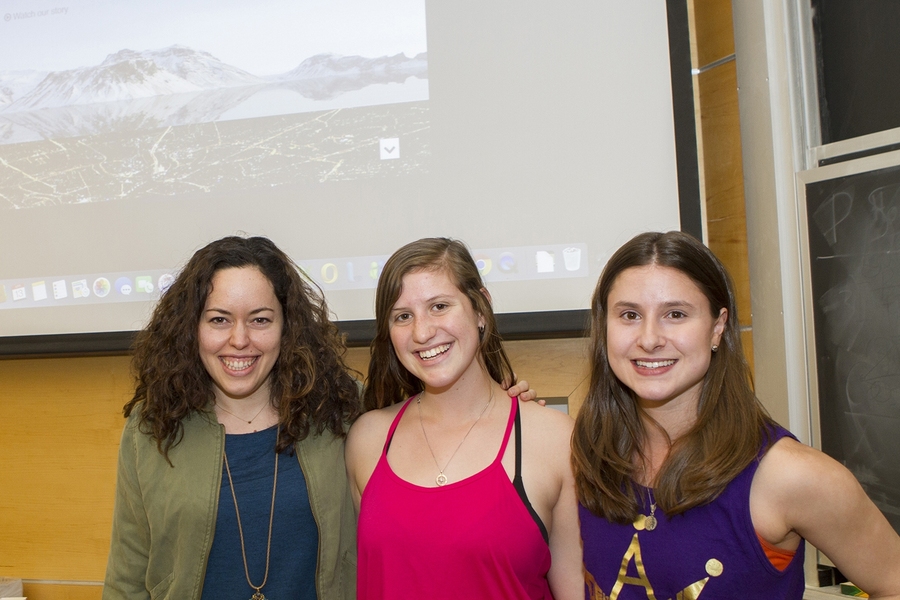“How can we reduce the environmental damage that agriculture so often causes and support the livelihood of farmers, all while continuing to feed the growing world population?”
This question was central to the winning entry at the fourth annual Department of Civil and Environmental Engineering (CEE) Video Competition. The video, “UAVs in Precision Agriculture,” produced by Alexa Jaeger, a junior in CEE and the Department of Earth, Atmospheric and Planetary Sciences, explored how students participating in Traveling Research Environmental eXperiences (TREX) are using unpiloted aerial vehicles (UAVs) to monitor soil quality across crop fields. By comparing the UAV images with soil samples, they are seeking to determine if this inexpensive method is a reliable way to gather crop health data across farms.
This year’s video competition challenged members of the CEE community to make a video that shows how Course 1 makes an impact on a global scale. Community members responded by sharing their creative approaches to explaining their fieldwork, lab research, and humanitarian aid trips. On April 13, CEE hosted a film screening of all the entries, complete with popcorn and movie theater candy.
“In CEE we see the world as our classroom. From research conducted in labs experiments here at MIT, to fieldwork around the world, Course 1 students are encouraged to apply what they learn to real-world applications” said Markus Buehler, head of CEE and the McAfee Professor of Engineering. “The video competition offers a unique way for members of the CEE community to showcase the variety of global approaches they take to solve the world’s major issues.”
Joining CEE as guest judges were Denny Freeman, dean for undergraduate education and professor of electrical engineering in the Department of Electrical Engineering and Computer Science; Jim Champy ’63, SM ’65, author and business consultant; and Erin Schenck, managing director of the MIT-Germany Program. The trio was tasked with evaluating each entry based on the global research, scientific inquiry, and engineering action, as well as how much passion and excitement was evident in the film.
“The videos were very compelling and cleverly produced,” Champy said. “They clearly presented the objectives of the projects and the excitement in their work. I was very impressed with our students' ability to express themselves though this medium.”
Freeman, Champy and Schenck awarded Jaeger’s “UAVs in Precision Agriculture” the first place award, which comes with a $1,000 prize. Attendees of the competition also gave Jaeger the People’s Choice award, which comes with an additional $100 prize.
“I wanted to share the global impact of TREX because it is so cool that undergraduates in Course 1 can participate in research that has such global and important applications. It isn't just a few undergrads either; anyone can take this class and participate. It was such a great experience learning about environmental fieldwork,” Jaeger said.
CEE senior Kathy Dieppa won second place and a $500 prize for her video “Back to Basics: Improving Access to Water and Sanitation in El Salvador.” Dieppa documented her Independent Activities Period service trip with MIT D-Lab to El Salvador, where she and fellow MIT students repaired water reservoirs, shared sanitation best-practices, and built latrines.
“In our society, it is often easy to forget that there are so many people in the world who are without the basic necessities that we often take for granted,” Dieppa said. “It's important to show that CEE research tackles some of the world's largest and most fundamental problems.”
The third-place prize and $250 was given to graduate students Tiziana Smith and Chi Feng for their entry, “Research for a Hungry World.” The video explained how by using data and simulations, researchers can understand how farming impacts the environment on local and global scales.
“As graduate students, we are trained in communicating our work to scientific audiences in longer forms like papers, presentations, and posters,” Smith said. “A two-minute video for general audiences really forces you to identify the essence of your work, and think of creative ways to verbalize and visualize it. The process is challenging, but also a lot of fun!”










